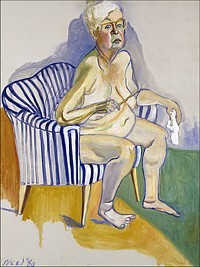
Alice Neel, Self-Portrait, 1980
Go Ask Alice, If You Dare
Have I said enough about maverick painter Alice Neel? You can read what I wrote in 2000, by going to my website . It’s an insider’s view, since I recount my experience as a nude victim for that merciless realist. On the other hand, I have heard my little essay is sometimes used as a prime example of storytelling as art criticism.
For another angle on Neel (1900-1984), one might turn to someone in her biological family rather than her art-world family. A documentary by her grandson Andrew Neel has recently been released. It’s called simply Alice Neel, now showing in New York at the small Cinema Village movie house, and a trailer is available at the film’s website. It skillfully blends new and archival footage to tell the Neel story: bohemian rebellion, free love, death and madness; poverty and empathy; and then, with a little help from her friends and a boost from ’60s feminism – triumph. You know, it’s just your same old, same old. But have you seen your grandma on Johnny Carson? Did your grandma paint you naked?
I usually hate artist bio-docs. This one is an exception, possibly because the basic material is so fascinating, and there are crucial twists and turns. Neel was dramatic without being self-dramatizing. Well, perhaps she was a little self-dramatizing. So is her grandson.
In some old footage, you see pre-pubescent Andrew jumping around nude in front of his grandma while she is trying to paint, which doesn’t bother her at all. And later in the film, we witness the director’s verbal altercation with his father, Hartley. Andrew is off-camera running the camera. And, let’s put it this way, words are exchanged. Clearly our director/cinematographer has the Alice Neel gene, best described as an eye plus temperament. The smart thing here, as he admits, is that without the family dirty laundry and the director’s presence, the film would turn into sentimental goo.
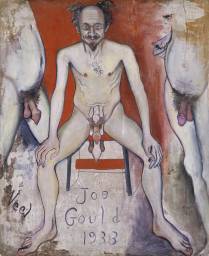
Neel, Joe Gould, 1933
Alice Doesn’t Live Here Anymore
As in his granny’s paintings, there is a dark side expressed in Andrew’s film. Late-night visitors pass through the sleeping room of young Hartley and Richard. The latter was apparently mistreated by Alice’s benefactor, John Rothchild. And did I mention Richard’s proclamation into his nephew’s lens that you won’t find anyone more right wing than himself? He was a teenage fan of Nixon, but Alice – the boys called her Alice — successfully forbade him from even mentioning that villain’s name in her presence. Hartley, who has more camera time, laments the toll of his mom’s bohemianism. Before their birth she, like many other lucky artists, was on the WPA and then later, as a single mother, was helped by welfare. Hartley became a doctor; Richard, a lawyer.
Neel once told me, loaded brush in hand, she had hoped that at least one of them would turn out to be a ballet dancer. No such luck.
It is, of course, a nice feel-good peak that Neel in the end had a big exhibition at the Whitney and was on Carson’s talk show twice. The talk-show sequences here are amusing indeed. But at what cost fame? Hartley, looking a bit depressed, has to admit that she was a good mother — although unable to protect Richard from being kicked under the table by Rothchild.
I think that because Neel was doing what she wanted to do, which was to paint all sorts of riff-raff — saints, sinners, and even eventually critics and museum directors – she was a better mother (and person) than if she had lived a horrid life of creative frustration. And took it out on her sons.
She chronicled the human comedy. And the tragedy. Late in life she had the devil in her eye. All her emperors had no clothes; and neither did anyone else. Everyone – sons, grandchildren, pregnant daughter-in-law, the Fuller Brush salesman – was naked to her gaze. I always tell people she was my real grandmother, my art grandmother.
After all, because of Neel’s nude portrait of me, now in the permanent collection of the Whitney Museum, I had my Warholian 15 minutes of fame. The photo editor at the Village Voice, without consulting me, used it to illustrate my September 27, 1973, review of Neel’s exhibition at the Graham Gallery.
The shock was not only the hairy frontal nudity, but the appearance that I might have chosen the illustration myself, never mind that I was writing about an exhibition that included the painting. Those were the so-called good old days. And Gregory Battcock, Jill Johnston and myself, like everyone else, were trying to make as much trouble as possible. Criticism had too many rules. Hadn’t Walt Whitman written his own review of Leaves of Grass and published it in the Brooklyn Eagle, where he worked?
What people did not know was that I had no say about the photos. If you look back at the Voice art pages in that period you will usually see a disconnect between my writings and the photos. As a poet, I knew how to compensate with brief word-pictures of what I found more interesting. The photos– as “a way of getting more art coverage” someone explained — usually showed coy artists peeking through or around their awful sculptures, not the Earth Art, Conceptual Art, and Streetworks I was inserting into the art discourse.
That photo of my naked portrait and its bold display is probably why in a recent review of the film Alice Neel, a writer referred to the notorious painting of John Perreault. Or did the writer mean the painting of the notorious John Perreault?
In 2000, when there was a second Alice Neel survey at the Whitney, the postcard of my nude portrait was the gift-shop best-seller. As I explained in a gallery talk at the museum, my 15 minutes of fame was now reduced to five minutes. Now I can report that the unidentified flash of the naked me in Alice Neel is now my two-second moment of worldwide fame. Fame like everything else has speeded up.
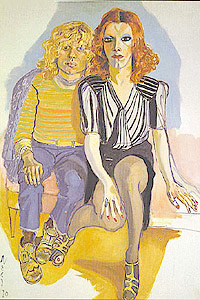
Neel, Rita Red and Jackie, 1979.
Alice’s Revenge
What we need now is a full-scale, scripted biography of Neel. I usually hate Hollywood, arty biographies. Lust for Life? Disgusting. But Neel’s life, with all those opportunities for satire, drama, and social commentary, would be something worth seen acted out.
My art grandmother Alice Neel was a jolly Stalinist to the end, if you can imagine such a thing. I think she liked that my real great-uncle had been an organizer for the Wobblies and a bigamist. But maybe not. The Wobblies did not fit the party line.
And, what a sharp tongue! She used to say at lectures that if only she had a wife like X (a realist painter) she’d be famous now too. She once got Warhol superstar Jackie Curtis into the stuffy University Club in full drag, “to have lunch and to see the paintings.” She told me, they were thrown out.
And she loved to gossip; she was a wicked, wicked gossip. She claimed to have painted the painting that allowed a certain famous art critic to get on the WPA as a painter. “And to this day he has never written about me,” I remember her complaining.
Which famous art critic? My lips are sealed.
But once, just once, I did best her.
John, she said to me on the telephone, “I’ve finally done it I’ve painted the lowest of the low. I’ve painted a woman who gets paid for peeing on men.” “But,” I replied, “Alice, you once told me bankers were the lowest of the low.” Pause. “You know, you’re right. They are.”
But here I think the most important thing for my Alice Neel Hollywood Movie is the casting. Although they never receive Academy Awards, casting directors are the unsung “writers” of many a movie. Choosing the right actors creates the characters. Of course, getting them to sign up is another problem, but we won’t go there. The Alice Neel Story has cultural value, as well as sex, violence, and a Rocky ending to a rocky life. Besides, who wouldn’t pay $12 to see a Norman Rockwell grandmother curse and talk about evil art world figures and corporate clowns, while painting all kinds of colorful characters in her Upper Westside living room, as the world goes up in smoke.
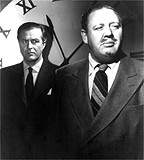
Ray Milland and Charles Laughton, The Big Clock, 1948.
Alice in Hollywood
Susan Sarandon has already played Alice, brilliantly, in The Secret Life of Joe Gould, so she might not want to repeat the role. And if the artist Louise Patterson in poet Kenneth Fearing’s classic noir novel The Big Clock is Neel, then Elsa Lanchester played her too – in the first film version, directed by John Farrow in 1948.
Neel had painted poet and pulpster Fearing. They shared left-wing political views, and she considered him a friend. In The Big Clock book – now shelved in my local B&N in literature, not mysteries — the artist has four children and not two; and a lover burns all of her art, not just the drawings and watercolors. In real life, dope fiend Kenneth Doolittle only burned the drawings and watercolors and then went on to slash the paintings. But Patterson’s laugh and bitterness, bred of lack of attention, are much like Neel’s.
The layered story is told through monologues. Here’s a quote from the Alice/Louise chapter, recounting the artist’s encounter with an investigator:
I looked at him through a haze of rage. He was another picture burner. I could tell it just by looking at his white, stuffy face. Another one of those decent, respectable maniacs who’d like nothing better than to take a butcher knife and slash canvases, slap them with paint, burn them. By God, he looked exactly like Pete. No, Pete’s way had been to use them to cover up broken window panes, plug up draughts, and stop leaks in the ceiling. He was more the official type. His method would be to bury them in an authorized warehouse somewhere, destroy the records, and let them stay there forever.
Kenneth Fearing, The Big Clock, 1946.Reprinted by Orion Books, London. Page 146.
This is sort of what happened to Neel’s WPA paintings. A plumbing company did indeed buy them to wrap pipes. Years later, someone I knew once found one nailed to a hot dog stand.
Perhaps by emphasizing Neel’s dark side, Fearing was taking his revenge for her wicked 1935 portrait, in which he seems to be smirking over life and death. In any case, he has Alice/Louise willfully not identify a man she thinks is a murderer because she hopes to get one of her long-lost paintings back from him. He is a collector or her art, and that seems to excuse everything.
The “hero,” George Stroud (drunkard, art collector, adulterer, and editor of a magazine within a Time/Life-type corporation), refers to the painting of a pair of hands holding a coin as The Temptation of St. Judas. This is perhaps a projection, but what or whom has Stroud betrayed by working for a publishing empire? Fearing himself sometimes wrote for Time magazine. Patterson calls the painting Study in Fundamentals. It sounds like something the real Neel might have painted in the ’30s, which would indeed, by 1945, have ended up in a Third Avenue “antique” shop, on sale for a steal.
Cast of Characters
Young Alice: Drew Barrymore….. will be the film that confirms she can act; just think Poison Ivy.
Mature Alice: Angela Lansbury….has the looks, the humor and the spunk.
Carlos Enriquez, the rich Cuban Neel ran away with to escape Moore College of Art in Philadelphia and/or to escape the Main Line: Adrien Brody…. actually looks like Neel’s portrait of Enriques.
Kenneth Doolittle: Robert Downey Jr…. because he knows how to chew the scenery.
Joe Gould, legendary author of the legendary “an oral history of our time”: Jack Nicholson….. has that Joe Gould twinkle, although, as far as I know, does not have three penises, as in Neel’s painting.
Jose Santiago, Richard’s father: Antonio Banderas…has to be handsome enough for Neel to pursue, and he is.
John Rothchild , travel agent and life-long friend; John Malkovitch….no explanation required, aside from the fact that he is the best villain ever and the most droll. He looks like Rothchild too.
Richard Neel: Jude Law….. would have to dye or un-dye his hair, but otherwise cool and perfect.
Hartley Neel: John Malkovitch…no explanation required aside from the fact that it would be fun to see the actor play two different parts in the same film.
Nancy Neel (Richard’s wife): Felicity Huffman… could really nail down Nancy’s patience and fortitude in attending to her mother-in-law.
Andy Warhol: Rufus Wainwright… would have to bleach his hair, but he could really do Warhol’s voice.
John Perreault: Nicholas Cage…he’s hairy enough and we have the same eyes.
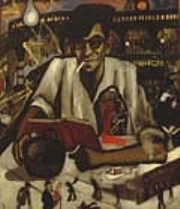
Neel, Kenneth Fearing, 1935
But who will play Kenneth Fearing, who not only wrote The Big Clock, but also
Aphrodite Metropolis:
Harry loves Myrtle–He has strong arms, from the warehouse,
And on Sunday when they take the bus to emerald meadows he doesn’t say:
“What will your chastity amount to when your flesh withers in a little while?”
No,
On Sunday, when they picnic in emerald meadows the look at the Sunday
paper.
GIRL SLAYS BANKER-BETRAYER
They spread it around on the grass
BATH-TUB STIRS JERSEY ROW
And then they sit down on it, nice.
Harry doesn’t say “Ziggin’s Ointment for withered flesh,
Cures thousands of men and women of motes, warts, red veins,
flabby throat, scalp and hair diseases,
Not expensive, and fully guaranteed.”
No,
Harry says nothing at all,
He smiles,
And they kiss in the emerald meadows on the Sunday paper.
Who will play other Neel painting subjects such as Henry Geldzahler, Walter Gutman, Jackie Curtis, Annie Sprinkle, Meyer Schapiro, Frank O’Hara, Clement Greenberg’s daughter, Harold Rosenberg, Robert Smithson, Dorothy “I’ll scratch her eyes out” Pearlstein, Linda Nochlin, Gregory Battcock?
And who will have the nerve and the verve to direct Alice’s Revenge?
Want to be e-mailed when new essays are posted? Contact: perreault@aol.com
John Perreault's art diary
